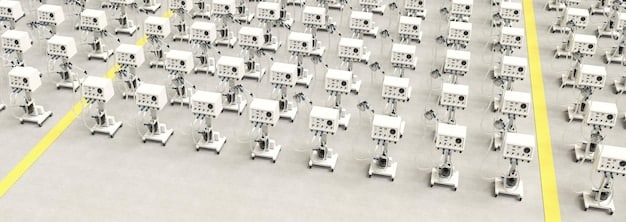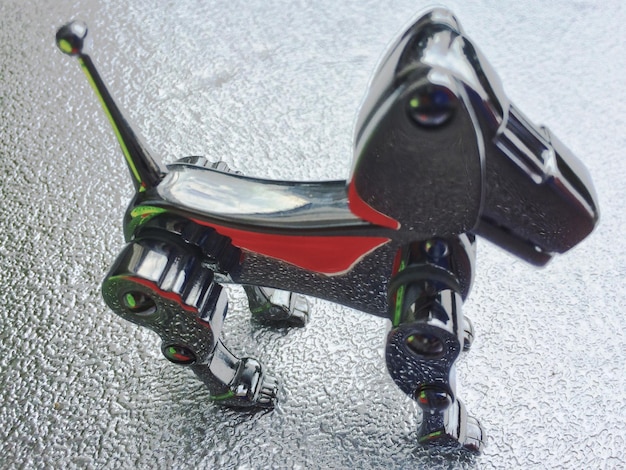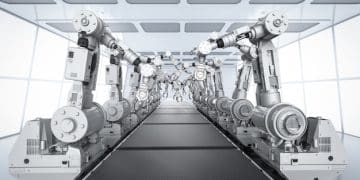Robotics in US Logistics: Optimizing Supply Chains and Reducing Delivery Times by 15%

The integration of robotics in US logistics is revolutionizing supply chain efficiency, significantly optimizing operations and demonstrating the potential to reduce delivery times by an impressive 15%, driven by enhanced automation, precision, and speed in various fulfillment processes.
The landscape of US logistics is undergoing a profound transformation, driven by innovative technological advancements. Among these, the integration of robotics in US logistics: optimizing supply chains and reducing delivery times by 15% stands out as a pivotal development, reshaping how goods move from origin to destination. This shift isn’t merely incremental; it represents a fundamental re-evaluation of efficiency, speed, and reliability within the vast and complex network that underpins the nation’s economy. As demand for faster, more accurate deliveries intensifies, robotics are emerging not just as a tool, but as a strategic imperative for businesses striving to remain competitive and responsive in a rapidly evolving market. This article explores the multifaceted impact of robotic solutions on the American supply chain, detailing how these intelligent machines are enabling unprecedented levels of optimization and the tangible gains, such as a projected 15% reduction in delivery times.
The Robotic Revolution in Modern Warehousing
The heart of any robust logistics network lies in its warehouses, and it is here that the robotic revolution is most dramatically palpable. Far from being simple storage facilities, modern warehouses are evolving into highly automated, intelligent hubs where robotics play a central role in every operation. These machines address critical challenges like labor shortages, throughput demands, and the sheer volume of e-commerce orders, transforming what was once a manual, labor-intensive process into a streamlined, high-speed ballet of automation.
Autonomous Mobile Robots (AMRs) and Automated Guided Vehicles (AGVs)
The proliferation of AMRs and AGVs is fundamentally changing how materials move within warehouses. Unlike traditional conveyor systems, these robots offer unparalleled flexibility and scalability. They navigate complex layouts, identify optimal routes, and transport goods with precision, significantly reducing the reliance on human operators for repetitive and often strenuous tasks. This not only enhances efficiency but also improves workplace safety.
- Enhanced Throughput: AMRs can operate 24/7, maintaining consistent speed and accuracy, which dramatically increases the volume of goods processed hourly.
- Dynamic Route Optimization: Equipped with sophisticated sensors and AI, AMRs continuously adapt to changing warehouse layouts and traffic, ensuring the fastest possible path for delivery.
- Reduced Labor Costs: By automating mundane tasks, companies can reallocate human workers to more complex, strategic roles, optimizing labor resources.
- Improved Accuracy: Robotic systems minimize human error in picking and sorting, leading to fewer mis-shipments and higher customer satisfaction.
Robotic Picking and Sorting Systems
Beyond transportation, robotic advancements in picking and sorting are particularly impactful. Robotic arms, often equipped with advanced vision systems and dexterous grippers, can now identify, pick, and place a wide array of products with remarkable speed and precision. This capability is crucial for e-commerce fulfillment, where a single order can contain diverse items from different sections of the warehouse.
As companies scale their operations, the ability to integrate diverse robotic systems seamlessly becomes paramount. This integration allows for a continuous flow of goods from receiving to dispatch, eliminating bottlenecks and accelerating the entire fulfillment process. The synergy between different types of robots – AMRs transporting goods to robotic picking stations, for example – creates a highly efficient, interconnected ecosystem. This integrated approach is a cornerstone of achieving the promised 15% reduction in delivery times by addressing inefficiencies within the warehouse itself.
Additionally, the data collected by these intelligent systems provides invaluable insights into warehouse performance, enabling continuous optimization and predictive maintenance. This proactive approach ensures operations run smoothly, minimizing downtime and further contributing to overall efficiency gains. The strategic deployment of these advanced systems underscores a commitment to innovation that positions US logistics at the forefront of global efficiency.
Optimizing the Last Mile: Robotics Beyond the Warehouse
While warehouses serve as critical nodes, the real challenge for delivery speed often lies in the “last mile”—the final leg of delivery from a distribution center to the customer’s doorstep. This segment is notoriously inefficient, accounting for a significant portion of overall logistics costs and delivery times. Robotics are now beginning to address these inefficiencies, offering innovative solutions that extend beyond the traditional confines of fulfillment centers.
Autonomous Delivery Vehicles
The concept of autonomous delivery vehicles, ranging from small sidewalk robots to larger self-driving vans, is rapidly moving from concept to reality. These vehicles promise to revolutionize urban and suburban deliveries by operating independently, delivering packages directly to consumers. This technology holds immense potential for reducing labor costs, increasing delivery frequency, and operating outside of typical human working hours.
For instance, sidewalk delivery robots are already deployed in limited capacities in several US cities, navigating pedestrian areas to drop off food or small packages. These robots offer a solution for congested urban environments where traditional vehicle deliveries are slow and costly. Their smaller footprint and electric propulsion also align with sustainability goals, reducing carbon emissions associated with last-mile logistics.
Drone Delivery Systems
Aerial drones represent another frontier in last-mile delivery. Capable of bypassing ground traffic, drones offer the promise of rapid delivery, particularly for smaller, high-priority items or in geographically challenging terrains. Companies like Amazon and Wing (Alphabet’s drone delivery service) are actively testing and deploying drone delivery programs, albeit under strict regulatory frameworks.
The use of drones could dramatically cut delivery times for specific parcels, especially for urgent medical supplies or time-sensitive documents. While regulatory hurdles related to airspace management and safety remain, the potential for widespread adoption is significant. The ability to deliver goods directly to a customer’s specific location without ground infrastructure reliance could redefine expectations for delivery speed.
The integration of these autonomous delivery methods is not without its challenges, including regulatory approvals, public acceptance, and the development of robust infrastructure for charging and maintenance. However, the potential for substantial improvements in delivery speed and cost-efficiency in the last mile is compelling. By automating this traditionally human-intensive and unpredictable segment, logistics providers can unlock further time savings, moving closer to the ambitious 15% reduction in overall delivery times. This strategic extension of robotic capabilities into the delivery phase highlights a holistic approach to supply chain optimization.

Addressing Labor Shortages and Enhancing Workplace Safety
The logistics industry in the US has long grappled with significant labor challenges, including high turnover rates, a scarcity of skilled workers, and physically demanding job roles. Robotics emerged not only as a solution for efficiency but also as a critical tool for addressing these human resource issues and significantly enhancing safety within operational environments. By automating repetitive, strenuous, or hazardous tasks, robots alleviate pressure on the human workforce and contribute to a safer, more sustainable work environment.
Mitigating Labor Scarcity
One of the most immediate benefits of integrating robotics is their ability to fill gaps created by labor shortages. Tasks such as picking, packing, sorting, and palletizing, which are often physically taxing and prone to high turnover, can be seamlessly handled by robots. This frees up human employees to focus on more complex, analytical, and strategic roles that require critical thinking, problem-solving, and direct customer interaction—areas where human intelligence remains indispensable.
For example, implementing robotic picking systems means a single human operator can supervise multiple machines, rather than manually lifting and scanning countless items. This enhances overall productivity without necessarily increasing the headcount on the floor. It also makes logistics jobs more appealing by shifting the focus from manual labor to oversight, maintenance, and technical support, attracting a new generation of skilled workers.
Improving Workplace Safety
Warehouses and logistics facilities can be inherently dangerous environments, with risks associated with heavy machinery, manual lifting, and repetitive motions leading to musculoskeletal injuries. Robotics play a crucial role in reducing these risks, fostering a safer workplace for human employees.
- Eliminating Repetitive Strain Injuries: Robots take over tasks that involve repetitive lifting, bending, and reaching, significantly reducing the incidence of strain injuries common among warehouse workers.
- Reducing Accidents with Heavy Equipment: Autonomous vehicles operate with highly precise navigation systems, minimizing human-related errors that can lead to collisions or accidents involving forklifts and other heavy machinery.
- Handling Hazardous Materials: Robots can be deployed in environments that are unsafe for humans, such as areas with extreme temperatures, poor air quality, or where hazardous materials are handled, protecting workers from exposure.
- Enhanced Situational Awareness: Many robotic systems are equipped with advanced sensors and cameras that provide real-time data, allowing for immediate detection of obstructions or potential hazards, thus preventing accidents.
By shouldering the burden of repetitive and dangerous tasks, robotics not only boost operational efficiency but also foster a work environment where human employees can thrive in roles that are less physically demanding and more intellectually stimulating. This dual benefit of addressing labor challenges and prioritizing safety underscores the comprehensive value proposition of robotics in the US logistics sector, contributing to a more resilient and attractive industry overall. The reduction in lost workdays due to injury also contributes indirectly to the overall efficiency gains needed to meet ambitious delivery time goals.
The Economic Impact: Cost Savings and ROI
Beyond the immediate benefits of speed and labor management, the economic impact of integrating robotics into US logistics operations is a compelling driver for adoption. The significant upfront investment in robotic systems is increasingly justified by substantial long-term cost savings and a measurable return on investment (ROI). These economic advantages are not merely speculative; they are demonstrating tangible improvements to a company’s bottom line, reinforcing the argument for widespread robotic deployment.
Reducing Operational Costs
Robotics offer multiple avenues for cost reduction across the supply chain:
- Lower Labor Expenses: While humans will always be essential, robots can reduce the need for extensive seasonal hiring or overtime, particularly during peak demand periods. This translates to direct savings on wages, benefits, and associated labor costs.
- Optimized Energy Consumption: Modern robotic systems are designed for energy efficiency, and in many cases, their predictable movement patterns can lead to more efficient use of warehouse space, reducing heating, cooling, and lighting expenses.
- Decreased Product Damage: The precision of robotic handling significantly reduces instances of damaged goods during sorting, picking, and transportation, leading to fewer returns, replacements, and associated losses.
- Reduced Rent/Real Estate Costs: By optimizing storage density and throughput in existing footprints, robotics can defer or eliminate the need for expanding or acquiring new warehouse space, a major capital expense.
These combined efficiencies mean that companies can process more orders with fewer resources, directly impacting their operational overheads and improving profit margins.
Measuring Return on Investment (ROI)
Calculating the ROI for robotic investments involves looking beyond initial purchase prices to encompass a holistic view of benefits.
The ROI is typically a calculation of the net profit of an investment divided by the cost of the investment, expressed as a percentage. For robotics, this includes savings from:
- Increased Throughput: The ability to process more orders faster directly translates into increased revenue potential, especially for e-commerce businesses.
- Reduced Delivery Times: Faster delivery, especially a 15% reduction, can lead to higher customer satisfaction, repeat business, and a stronger competitive advantage, all of which contribute to revenue growth.
- Lower Error Rates: Fewer incorrect orders or damaged items reduce reverse logistics costs and improve brand reputation.
- Improved Labor Utilization: Reallocating human talent to higher-value activities can lead to innovation and strategic growth.
While the exact ROI period varies depending on the scale and type of robotic deployment, industry data and early adopters consistently report payback periods that make these investments highly attractive. Some analyses indicate that well-planned robotic integrations can achieve ROI within 2-3 years, sometimes even faster.
The fundamental shift facilitated by robotics is not just about isolated cost reductions, but about creating a more agile, resilient, and economically efficient logistics network. This ability to deliver more for less, while simultaneously enhancing service quality, underscores the transformative power of robotics in strengthening the economic backbone of US logistics and securing its competitive edge in the global marketplace.
Challenges and Future Outlook of Robotics in US Logistics
Despite the undeniable advantages and growing adoption, the widespread integration of robotics in US logistics is not without its hurdles. Navigating these challenges effectively will be crucial for realizing the full potential of robotic automation and achieving the ambitious targets, such as a 15% reduction in delivery times. Understanding these obstacles and developing strategic solutions is key to charting a successful future for robotics in the sector.
Implementation Challenges
The path to robotic integration can be complex, involving significant upfront planning and investment. Some of the primary implementation challenges include:
- High Initial Investment: The cost of purchasing, installing, and integrating sophisticated robotic systems can be substantial, posing a barrier for smaller and medium-sized enterprises (SMEs).
- Integration Complexity: Robotic systems often need to be seamlessly integrated with existing warehouse management systems (WMS) and enterprise resource planning (ERP) software, which can be a technically demanding and time-consuming process.
- Workforce Retraining: While robots reduce the need for certain manual tasks, they create a demand for new skills—such as robotic operation, maintenance, and programming. This requires significant investment in workforce retraining and upskilling.
- Scalability and Flexibility: Designing robotic systems that can easily adapt to fluctuating demand, seasonal peaks, and changes in product mix requires careful planning and modular design.
Addressing these issues often requires a phased approach, starting with pilot programs, and fostering partnerships with technology providers for smoother implementation and support.
Regulatory and Ethical Considerations
As robotics become more ubiquitous, particularly in public spaces for last-mile delivery, regulatory and ethical concerns come to the forefront:
- Public Safety Regulations: Ensuring the safe operation of autonomous vehicles and drones in urban and suburban environments requires strict regulatory frameworks regarding traffic laws, airspace management, and liability.
- Data Privacy and Security: Robotic systems collect vast amounts of data, raising concerns about data privacy for individuals and businesses, as well as the cybersecurity of the integrated networks.
- Job Displacement Concerns: While robotics create new jobs, there are legitimate concerns about traditional job displacement. Addressing these involves public policy, education, and social safety nets to support transitions.
- Ethical AI Considerations: As robots become more intelligent and autonomous, ethical guidelines for their decision-making processes, especially in unpredictable situations, will become increasingly important.
Future Outlook
Despite these challenges, the trajectory for robotics in US logistics is overwhelmingly positive. Continued advancements in artificial intelligence (AI), machine learning, sensor technology, and battery life will further enhance the capabilities and cost-effectiveness of robotic solutions. We can anticipate:
- Greater Interoperability: Robots from different manufacturers will be able to communicate and work together more effectively, creating more agile and resilient supply chains.
- “Lights-Out” Operations: The development of fully automated warehouses that can operate with minimal or no human presence during certain shifts, maximizing throughput.
- Hyper-Personalized Logistics: Robotics will enable even more granular and personalized delivery services, adapting to individual customer preferences and immediate needs.
- Sustainable Logistics: Continued focus on energy-efficient robots and electric autonomous vehicles will contribute significantly to the logistics industry’s sustainability goals.
The journey towards a fully roboticized logistics network in the US is ongoing, but the momentum is clear. By proactively addressing current challenges and embracing future innovations, the sector is poised to unlock unprecedented levels of efficiency, responsiveness, and resilience, firmly establishing the foundational improvements needed for achieving and even exceeding the target of a 15% reduction in delivery times. This proactive approach ensures that US logistics remains at the cutting edge of global supply chain management.
Emerging Technologies and Their Role in Further Optimization
The current generation of robotics integrated into US logistics is impressive, but the rapid pace of technological innovation suggests that even greater efficiencies are on the horizon. Several emerging technologies are poised to complement existing robotic systems, pushing the boundaries of supply chain optimization and contributing further to the goal of reducing delivery times by 15% or more. These advancements promise to make robotic operations even smarter, more adaptive, and more pervasive across the logistics landscape.
Artificial Intelligence (AI) and Machine Learning (ML)
AI and ML are the brains behind sophisticated robotic operations. While already present, their continued evolution will lead to robots that are more intelligent, capable of learning from their environments, and making increasingly complex decisions autonomously.
- Predictive Analytics: AI-powered robots can analyze vast datasets to predict inventory needs, identify optimal routes, and even foresee equipment maintenance requirements, minimizing downtime.
- Enhanced Vision Systems: Advanced computer vision, driven by AI, enables robots to recognize, classify, and handle a wider variety of objects, even those with irregular shapes or fragile compositions, with greater accuracy.
- Self-Optimization: ML algorithms allow robotic fleets to continuously optimize their own performance, learning from past interactions and adapting to new challenges in real-time, leading to dynamic efficiency gains.
Swarm Robotics and Collaborative Systems
The concept of “swarm robotics” involves multiple robots working together as a coordinated unit to achieve a common goal, without centralized control. This distributed intelligence offers significant advantages in flexibility and redundancy.
Imagine hundreds of small, autonomous robots collaboratively sorting packages or building pallets, dynamically reconfiguring their tasks based on real-time needs. If one robot fails, others seamlessly pick up the slack, ensuring continuous operation. Collaborative robots (cobots), designed to work safely alongside humans, are also becoming more sophisticated, allowing for flexible workflows where humans and machines augment each other’s capabilities. This human-robot collaboration blends the best of human dexterity and problem-solving with robotic speed and precision.
Advanced Sensing and Navigation
Future robotics will integrate even more sophisticated sensors, including advanced LiDAR (Light Detection and Ranging), improved ultrasonic sensors, and hyper-accurate GPS, enabling unparalleled navigation precision and environmental awareness.
* Indoor Positioning Systems (IPS): While GPS works outdoors, IPS technologies (e.g., UWB, Wi-Fi, Bluetooth beacons) will provide centimeter-level accuracy for robots operating inside complex, multi-level warehouses.
* 3D Mapping and Environmental Data: Robots will build and continuously update high-definition 3D maps of their surroundings, allowing for more precise movements and better obstacle avoidance in dynamic environments.
* Tactile Sensing: Enhanced tactile sensors will give robots a more delicate “sense of touch,” enabling them to handle fragile items with greater care and perform more intricate manipulation tasks.
These emerging technologies are not merely incremental improvements; they represent foundational shifts that will unlock new paradigms of efficiency and flexibility in US logistics. As these innovations mature and become more accessible, they will drive the industry towards even greater automation, ultimately solidifying the role of robotics as the cornerstone of optimized supply chains and significantly contributing to faster, more reliable deliveries nationwide. The synergy between current robotic systems and these future technologies promises a truly transformative impact, securing a competitive edge for American businesses.
Case Studies: Real-World Impact and Success Stories
The theoretical promises of robotics in logistics are powerful, but their true impact is best illustrated through real-world applications. Numerous companies across the US, from retail giants to specialized logistics providers, have already integrated robotic solutions into their operations, demonstrating tangible benefits and validating the potential for significant improvements in efficiency and delivery times. These success stories provide compelling evidence of robotics’ transformative power.
Amazon: A Pioneer in Robotic Warehousing
Perhaps no company exemplifies the large-scale integration of robotics more than Amazon. Since acquiring Kiva Systems (now Amazon Robotics) in 2012, Amazon has deployed hundreds of thousands of autonomous mobile robots (AMRs) across its fulfillment centers worldwide. These robots literally bring shelves of products to human pickers, dramatically reducing the time and effort required to fulfill orders.
* Before Robotics: Human pickers would walk miles within a warehouse to retrieve items for a single order.
* After Robotics: AMRs retrieve the shelves, bringing them directly to fixed picking stations, cutting down walking time to almost zero. This has vastly increased throughput and reduced order fulfillment times. The company’s ability to offer same-day and next-day delivery in many areas is largely a testament to this robotic efficiency, playing a crucial role in their ability to reduce delivery times across their vast network.
Walmart: Automating Micro-Fulfillment Centers
Walmart, a major competitor in the retail and e-commerce space, is also heavily investing in robotics, particularly for its micro-fulfillment centers (MFCs). These smaller, highly automated centers are typically located closer to urban areas, enabling faster online grocery and general merchandise pickup and delivery.
Walmart utilizes robotic systems for automated storage and retrieval (AS/RS) and robotic picking to quickly assemble online orders. By bringing these automated processes closer to the customer, Walmart significantly reduces the time and cost associated with the last mile. This strategy directly contributes to their efforts to shorten delivery windows, competing effectively with other e-commerce players by providing rapid local fulfillment.
FedEx and UPS: Innovations in Sorting and Last Mile
Major parcel carriers like FedEx and UPS are also integrating robotics to enhance their massive sorting facilities and explore last-mile delivery solutions.
* Automated Sorting: Both companies use sophisticated robotic sorting systems that can process thousands of packages per hour, ensuring they are directed to the correct outbound routes with high accuracy. These systems are crucial for handling the immense volume of parcels, especially during peak seasons, and for maintaining tight deadlines.
* Last-Mile Pilots: FedEx has piloted Roxo, an autonomous delivery robot designed for sidewalk deliveries, while UPS has explored drone delivery for specific scenarios, like medical supplies in remote areas. These initiatives aim to bypass traffic congestion and reduce delivery times for critical or urgent items.
These case studies illustrate that robotics are not just theoretical solutions but are actively driving efficiency, reducing costs, and, most importantly, accelerating delivery times across the US logistics sector. The success of these pioneering companies sets a precedent, demonstrating the tangible advantages and paving the way for broader adoption across the industry, further contributing to the projected 15% reduction in overall delivery times. The proven track record of these major players provides a compelling narrative for other businesses to follow suit, ensuring that the benefits of robotic integration are widespread.
| Key Point | Brief Description |
|---|---|
| 🤖 Warehouse Efficiency | Robots revolutionize sorting, picking, and packing, accelerating throughput and enhancing accuracy in fulfillment centers. |
| 🚚 Last-Mile Optimization | Autonomous vehicles and drones are reducing delivery times and costs by automating the final leg of customer delivery. |
| 👷 Safety & Labor Solutions | Robotics address labor shortages and improve workplace safety by handling repetitive and hazardous tasks. |
| 💰 Economic Impact | Significant cost savings and a strong ROI are driving widespread adoption, improving operational efficiency and profitability. |
Frequently Asked Questions about Robotics in US Logistics
▼
Robotics achieve this reduction by automating numerous time-consuming processes across the supply chain. In warehouses, they speed up picking, packing, and sorting, eliminating bottlenecks. In the last mile, autonomous vehicles and drones bypass traffic and operate 24/7. This combined efficiency across different segments of the logistics journey leads to significant overall time savings, often reaching or exceeding the 15% target by streamlining formerly manual and slow steps.
▼
While robots automate repetitive tasks, they are primarily changing the nature of jobs rather than simply replacing them. The industry sees a shift from manual labor to roles requiring technical skills like robot operation, maintenance, and data analysis. This creates new opportunities for skilled technicians and engineers, elevating the overall skill set required within the logistics workforce. Many human workers are being reskilled for higher-value activities.
▼
The primary types of robots in US logistics warehouses include Autonomous Mobile Robots (AMRs) and Automated Guided Vehicles (AGVs) for transporting goods, and robotic arms for picking, packing, and sorting. Collaborative robots (cobots) are also increasingly used to work alongside human employees, assisting with various tasks. These robots often integrate advanced vision systems, AI, and machine learning for enhanced autonomy and precision in their operations.
▼
Yes, for many logistics operations, the high initial investment in robotics is justified by substantial long-term benefits. These include significant reductions in operational costs due to lower labor expenses, increased efficiency leading to higher throughput, decreased product damage, and optimized space utilization. The return on investment (ROI) often comes within a few years, making robotics a financially viable and strategic decision for businesses seeking competitive advantage and long-term sustainability.
▼
Widespread adoption of last-mile delivery robots faces several regulatory challenges. These include establishing clear guidelines for their operation on public sidewalks and roads, addressing safety concerns regarding interaction with pedestrians and vehicles, and navigating complex airspace regulations for drones. Additionally, liability issues, data privacy, and the need for standardized operating procedures across different municipalities require comprehensive legal and policy frameworks before broad deployment can occur.
Conclusion
The integration of robotics within US logistics is not merely a trend but a fundamental shift that is redefining the very essence of supply chain management. From highly automated warehouses to the innovative deployment of autonomous vehicles and drones in the last mile, these intelligent machines are proving indispensable in the quest for greater efficiency, accuracy, and speed. The projected 15% reduction in delivery times is a testament to their transformative power, underscoring how robotics are addressing critical challenges such as labor shortages, escalating operational costs, and the relentless demand for faster fulfillment. While obstacles like initial investment and regulatory complexities remain, the trajectory is clear: robotics will continue to be a cornerstone of a more resilient, optimized, and responsive US logistics network, ensuring that the nation’s supply chains remain at the vanguard of global innovation and competitiveness.





